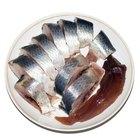
It may smell terrific and look even better in the saucepan, but when you conduct the all-important taste test of your cream sauce, it’s so bland you may be tempted to either pitch a fit or pitch the sauce. But don’t give up hope just yet. There are ways to save a bland cream sauce beyond the standard additions of salt and pepper. Try to blend flavors that are compatible with the type of sauce you’re preparing. With a little practice and experimentation, your cream sauce will be a standout.
Step 1
Spice up béchamel – a white sauce – with ground thyme and a pinch of fresh nutmeg. Salt and pepper are needed, too, but you may opt for white pepper if you wish to keep the sauce looking pristine. Cream and butter are guaranteed to add texture and flavor to white sauces, so if yours is bland, try adding a bit more of each and taste the sauce after each small addition.
Step 2
Turn to basil, garlic and oregano to wake up a sleeping tomato cream sauce. Add some feta cheese, diced onion or crumbled bacon for good measure. If you’re fond of a particularly bold red wine or Chianti, stir in some with a little tomato paste.
Step 3
Say “adieu” to an unfriendly French cream sauce by adding some Dijon mustard, shallots and white wine. Flavor the sauce with herbes de Provence, a complex blend of spices named for the Provence region of France that often includes basil, bay leaf, chervil, fennel, lavender, marjoram, oregano, rosemary, sage, summer savory, tarragon and thyme.
Step 4
Encourage a Chinese cream sauce by adding five-spice powder, a blend of anise, cinnamon, cloves, ginger and star anise. Fresh ginger and peanut butter are also natural choices for Chinese sauces, as is the finishing touch of toasted sesame oil.
Step 5
Add fire to white and red cream sauces alike by adding finely diced peppers and aromatics with a bite. Consider shallots, garlic, red and yellow peppers or chilies. Add a dash of red pepper flakes or chili powder, but do so sparingly. You can always add more zip but cannot remove it.
Step 6
Experiment and try not to be afraid to take risks as you enliven your sauces. Start out by adding a small handful of fresh chives or a dash of peppercorns, if you like the flavor. Visit the bottled seasoning section of a specialty grocer and explore your options. For example, chutney is a fruit and herb-flavored sauce that is as good in sauces as it is on pork. Indulge your daring side by chopping some nuts to add to your sauces; they’ll add flavor and texture.
Related Articles

How do I Make Turkish Chili Sauce?

How to Make Fish Taco Sauce

How to Make Hibachi Mustard

How to Make Plum Sauce

How to make Stuffed Jalapeno Peppers ...

The Ingredients in Chipotle Sauce

Peruvian Cooking Spices

How to Make a Real, Authentic Ponzu ...

How Can I Counteract the Sourness of a ...

How to Tone Down Spiciness in BBQ Sauce

Pork Spare Rib Marinade for Grilling

How to Make Creamy Alfredo Sauce With ...

Herring in Wine Sauce

Low Sodium Substitute for Condensed ...

A Good Substitute for Hoisin Sauce

How to Cook a Strip Pepper Steak in the ...

How to Freeze Tzatziki

How to Make Tomato Bruschetta
How to Pickle Tabasco Peppers With ...

How to Make Eggs Benedict With ...
References
Resources
Tips
- Take notes as you experiment with herbs and seasonings. The process might slow you down, but try to take the long view: a dash of “this, that and the other thing” won’t help you if your family clamors for you to recreate a flavorful, inventive sauce.
Writer Bio
Mary Wroblewski earned a master'sdegree with high honors in communications and has worked as areporter and editor in two Chicago newsrooms. She launched her ownsmall business, which specialized in assisting small business ownerswith “all things marketing” – from drafting a marketing planand writing website copy to crafting media plans and developing emailcampaigns. Mary writes extensively about small business issues, andespecially “all things marketing.”
Photo Credits
Pixland/Pixland/Getty Images